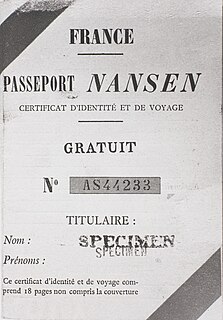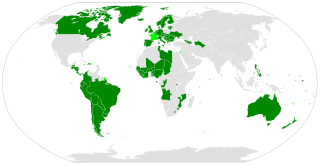
Nansen passports, originally and officially stateless persons passports, were internationally recognized refugee travel documents from 1922 to 1938, first issued by the League of Nations to stateless refugees. They quickly became known as "Nansen passports" for their promoter, the Norwegian statesman and polar explorer Fridtjof Nansen.
In international law, a stateless person is someone who is "not considered as a national by any state under the operation of its law". Some stateless people are also refugees. However, not all refugees are stateless, and many people who are stateless have never crossed an international border. On November 12, 2018, United Nations High Commissioner for Refugees warned there are about 12 million stateless people in the world.

A certificate of identity, sometimes called an alien's passport, is a travel document issued by a country to non-citizens residing within their borders who are stateless persons or otherwise unable to obtain a passport from their state of nationality. Some states also issue certificates of identity to their own citizens as a form of emergency passport or otherwise in lieu of a passport. The visa requirements of certificates of identity may be different from those of regular passports.
The World Passport is a fantasy travel document sold by the World Service Authority, a non-profit organization founded by Garry Davis in 1954.

A machine-readable passport (MRP) is a machine-readable travel document (MRTD) with the data on the identity page encoded in optical character recognition format. Many countries began to issue machine-readable travel documents in the 1980s.
A travel document is an identity document issued by a government or international treaty organization to facilitate the movement of individuals or small groups of people across international boundaries, following international agreements. Travel documents usually assure other governments that the bearer may return to the issuing country, and are often issued in booklet form to allow other governments to place visas as well as entry and exit stamps into them. The most common travel document is a passport, which usually gives the bearer more privileges like visa-free access to certain countries. However, the term is sometimes used only for those documents which do not bear proof of nationality, such as a refugee travel document.

A refugee travel document is a travel document issued to a refugee by the state in which she or he normally resides allowing him or her to travel outside that state and to return there. Refugees are unlikely to be able to obtain passports from their state of nationality and therefore need travel documents so that they might engage in international travel.

The Convention on the Reduction of Statelessness is a 1961 United Nations multilateral treaty whereby sovereign states agree to reduce the incidence of statelessness. The Convention was originally intended as a Protocol to the Convention Relating to the Status of Refugees, while the 1954 Convention Relating to the Status of Stateless Persons was adopted to cover stateless persons who are not refugees and therefore not within the scope of the Convention Relating to the Status of Refugees.

The Ukrainian passport is a document issued for nationals of Ukraine as proof of Ukrainian citizenship. It is used for overseas travel. An internal passport soft booklet was the primary identification document of Ukrainian citizens used within Ukraine until 2016, when a credit card-sized identity card was introduced. However previously issued internal passports remain valid.

The Macao Special Administrative Region Travel Permit is a biometric international travel document issued to non-permanent residents of Macau SAR holding Chinese nationality, who also possess a Macau SAR Non-Permanent Resident Identity Card, and are not eligible for any other type of travel document. Permanent residents of Macau of non-Chinese nationality are also eligible.

The New Zealand Certificate of Identity is an international biometric travel document issued by the Department of Internal Affairs to an alien resident of or visitor to New Zealand who is unable to obtain a national passport, or has a national passport unacceptable to Immigration New Zealand so that they can leave New Zealand. It is not usually issued to a person whose government is represented in either New Zealand or Australia.
The Home Office travel document is an international travel document issued by the UK Border Agency to an alien resident of United Kingdom who is unable to obtain a national passport. It is usually valid for five years, or if the holder only has temporary permission to stay in the United Kingdom, the validity will be identical to the length of stay permitted.

The Canadian Certificate of Identity is an international travel document issued by Immigration, Refugees and Citizenship Canada to a permanent resident of Canada who is not yet a Canadian citizen, is stateless, or is otherwise unable to obtain a national passport or travel document. It is a biometric document with a grey cover and is bilingual in both English and French. The validity period of the travel document is determined by the issuing office.
The Singaporean Certificate of Identity is an international travel document issued by the Immigration and Checkpoints Authority to Singaporean permanent residents who are stateless.
The Bruneian International Certificate of Identity (ICI) is an international travel document issued by the Immigration and National Registration Department to Bruneian permanent residents who are stateless. It is valid for five years.

The Japan Re-entry Permit (再入国許可書), is a travel document similar to a certificate of identity, issued by Japan's Ministry of Justice. It is a passport-like booklet with a light brown cover with the words "再入国許可書 RE-ENTRY PERMIT TO JAPAN" on the front.

The Australian Certificate of Identity (COI) is a biometric travel document issued by the Department of Foreign Affairs and Trade to individuals who are not Australian citizens and are about to leave Australia or one of its territories.

The Re-entry Permit is a travel document similar to a certificate of identity, issued by the United States Citizenship and Immigration Services to U.S. lawful permanent residents to allow them to travel abroad and return to the United States. It is a passport-like booklet with a blue-green cover with the words "TRAVEL DOCUMENT" on the front. Individuals whose application for permanent residency has not yet been approved can instead apply for advance parole.
Humanitarian visas are visas granted by some countries in order to fulfill their international obligation to protecting refugees from persecution. The Convention Relating to the Status of Refugees is often used as the main criteria in assessing whether or not there is a legitimate claim for protection, which defines a refugee as a person who:
An Indian Identity Certificate, simply known as Identity Certificate (IC), is a travel document issued by the Passport Seva, Consular, Passport & Visa (CPV) Division of the Ministry of External Affairs, Government of India to non-citizens of the Republic of India for foreign travel. It enables the bearer to travel internationally and serves as proof of identity as per the Passports Act (1967). It is mostly issued to Tibetan refugees, along with other stateless people. Since 28 June 2016, Sweden is no longer accepting the Indian Identity Certificate as a travel document. However, on 9 October 2018, Sweden started accepting the Indian Identify Certificate for Tibetan Refugees on the condition that they have no objection to returning to India.













